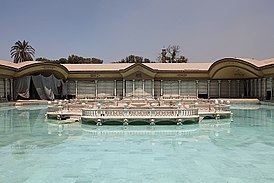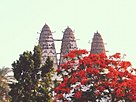Shubra El Kheima
Shubra El Kheima
شبرا الخيمة | |
|---|---|
Clockwise from top: Shubrah Palace, Shubrah Palace Facade, Pigeon towers, Al-Qanatir | |
| Coordinates: 30°7′43″N 31°14′32″E / 30.12861°N 31.24222°E | |
| Country | Egypt |
| Governorate | Qalyubia |
| Area | |
• Total | 30.0 km2 (11.6 sq mi) |
| Elevation | 26 m (85 ft) |
| Population (2021)[1] | |
• Total | 1,240,289 |
| • Density | 41,000/km2 (110,000/sq mi) |
| Time zone | UTC+2 (EST) |
Shubra El Kheima, (Arabic: شبرا الخيمة, lit. 'hamlet of the tent', IPA: [ˈʃobɾɑ lˈxeːmæ], from Coptic: ⲥⲁⲡⲣⲟ ϩⲃⲱ, lit. 'hamlet of tent'[2]) is the fourth-largest city in Egypt after Cairo, Giza and Alexandria. It is located in the Qalyubia Governorate along the northern edge of the Cairo Governorate.[3] It forms part of the Greater Cairo metropolitan area.
History and demographics
[edit]Shubra El Kheima was a village on the Nile where Mohamed Ali built a palace in its vicinity in 1908 as a rural retreat.
During the 20th Century, the area became primarily inhabited by workers and their families, as it became a major industrial hub.
Today, along with the cities of Cairo and Giza, Shubra al-Kheima makes up the contiguous metropolitan area of Greater Cairo. In the 2017 census it was home to 1,161,514 people,[4] divided between two districts comprising five shiakhas (smallest non-administrative census blocks):[5]
- District 1: (hayy awwal): 481,936 people.
| Shiakha | Code 2017 | Population |
|---|---|---|
| Shubrâ al-Khayma | 141001 | 20,175 |
| Bîjâm | 141002 | 435,076 |
| Damanhûr Shubrâ | 141003 | 26,685 |
- District 2 (hayy thani): 679,578 people.
| Shiakha | Code 2017 | Population |
|---|---|---|
| Bahtîm | 141101 | 545,540 |
| Musṭurud | 141102 | 134,038 |
Transportation
[edit]Shubra El Kheima station serves the northern terminus of Line 2 of the Cairo Metro. Near the metro station, there is also a station within the Egyptian National Railways system.
Shubra El Kheima is also served by taxis, CTA-owned and private buses, microbuses, and in the case of poorer districts, tuk tuks.
Landmarks
[edit]Mohamed Ali Pavilion
[edit]Shubra El Kheima hosts the Fountain Pavilion of Mohamed Ali Pasha, built in 1821 as part of a palace complex that no longer exists.[6][7] He chose an isolated palace or an official residence away from the Citadel in the district called Shubra, the construction of the palace began in 1808 and it was completed in 1821. The Palace of Mohammad Ali or Shubra Palace is distinguished by its style of decoration that mixes between the Islamic style of decoration and the European one.
Gallery
[edit]-
Nightview from the train station
-
Shubra el-Kheima metro station
-
Saint Theresa Church
-
Protesters during 2011 Arab Spring
-
Panoramic view of Shubra on the Nile
References and Notes
[edit]- ^ a b c "Egypt: Governorates, Major Cities & Towns - Population Statistics, Maps, Charts, Weather and Web Information". www.citypopulation.de. Retrieved 18 March 2023.
- ^ Peust, Carsten. "Die Toponyme vorarabischen Ursprungs im modernen Ägypten" (PDF). p. 89.
- ^ "Shubra al-Kheima City". www.qaliobia.gov.eg. Retrieved 2023-02-12.
- ^ "2017 Census for Population and Housing Conditions". CEDEJ-CAPMAS.
- ^ "Administrative map of Shubra al-Kheima". www.qaliobia.gov.eg. Retrieved 2023-02-12.
- ^ Abd Al-Wahab, Hassan (1941). "Mohamed Ali's Palace, Shubra". Majallat al-Imarah (in Arabic).
- ^ Rafaat, Samir (December 2005). "RE-LAUNCH OF THE SHUBRA PAVILION". www.egy.com. Retrieved 2023-02-08.
External links
[edit]![]() Media related to Shubra El-Kheima at Wikimedia Commons
Media related to Shubra El-Kheima at Wikimedia Commons












